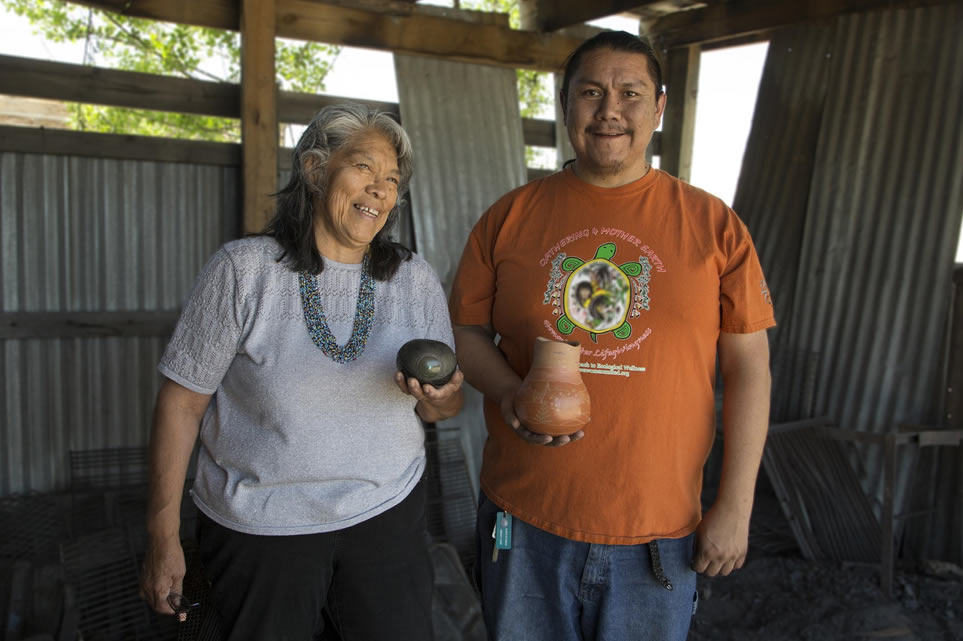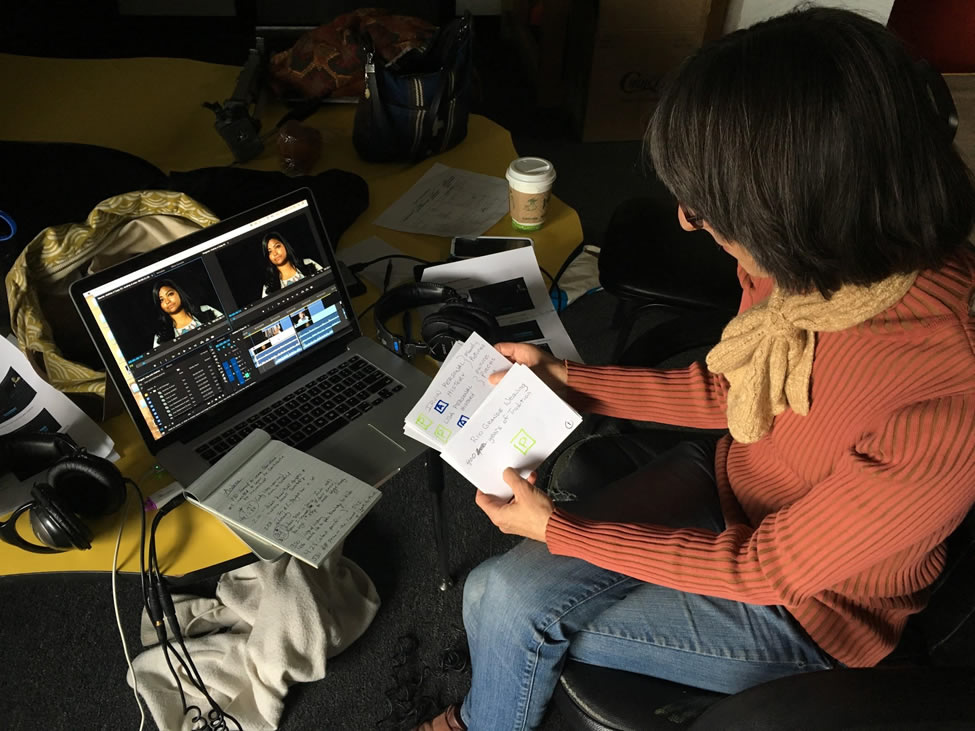Documentary Apprenticeship Program MOIFA’s Gallery of Conscience and Little Globe Media
Posted on Nov 29, 2016

We started with a traditional idea - a Master-apprenticeship program which would support renowned folk artists and their students in the teaching of traditional arts. Bridging the generations, the program would involve a transmission of craft, skills and community history. Most of the master artists—all renowned traditional artists from New Mexico-- were part of our Gallery of Conscience’s current exhibition, which explores the strategies folk artists use to survive and thrive in today’s global marketplace. Both the master artists and the apprentices spoke beautifully of their desire to be a part of this project to transmit traditional knowledge, skills and techniques across generations:
"I wanted to participate in this program to model for my tribe, that gaining knowledge in traditional weaving makes us stronger. I wanted them to be inspired to participate so that we can be one in spirit with our ancestors." ~Antonio Jojola, spiritual leader, army veteran and First War Captain of the Piro Manso Tiwa Tribe, Las Cruces New Mexico
“It is difficult to find young people that want to do colcha embroidery, the youth are moving on. Their daily life and technology is fast, and colcha embroidery is slow, meditative and historic, and doesn’t give you an immediate product like you get from computers. To the young people it’s old fashioned. I wish more young people wanted to learn because anything that you do with your hands is very satisfying and enriching to your life. I know the future is technology and that’s good, but in times of stress, I think it’s good to learn to work with your hands, feel your materials, and express your creativity.” ~ Julia Gomez, colcha embroiderer, Santa Fe New Mexico
But we wanted to go further.
We felt it was important to not only bridge generations, but bridge the old and new ways of learning and transmitting knowledge.
What if we taught artists how to share their traditions in a contemporary format? To document their collaborations, document their crafts and the cultures behind them, and share that with the world? What if they learned to do this on their cell phones, so that they could easily repeat the process again and again?
We wanted to give artists a microphone, to teach them the tools of digital storytelling.
In a partnership between the Museum of International Folk Art’s Gallery of Conscience and Little Globe’s Youth Media Project, we devised a collaborative program to support the transmission of traditional arts across generations, and teach artists a skill set to make their own videos. Our funders, the National Endowment for the Arts and the McCune Charitable Foundation, were particularly excited about this kind of collaboration, and the transmission of contemporary media skills along with age-old traditional arts.
The artists jumped at the opportunity as well:
“As a weaver, a teacher and a business owner, I am very interested in learning digital storytelling; it’s something we’ve needed for a while but has been out of our reach until now. I want to develop these skills, and make videos to use as both teaching and marketing tools. We have to represent ourselves to the public in many ways, and this is a new tool to do that.”
~ Lisa Trujillo, weaver and co-owner of Centinela Traditional Arts, Chimayo, New Mexico
From Pueblo weaving, to Colcha embroidery, to Yoruba Indigo dying, to Chimayo fiber arts, to Pueblo jewelry making, six pairs of artists embarked on a six month journey. Each artist had one apprentice - either a son or daughter, a more junior artist from the community, or a high school student interested in the traditional arts and culture of her state. One of the apprentices was even an elder in the Pueblo community.
In June 2016, the first workshop kicked off the project with an introduction to new media. How to tell a story in a digital form - questions of narrative, voice, audience, tone, message. Ways to layer a story, integrating music, sound clips, video clips, photos, and formal interviews. Artists were taught elements of documentary - using their phones - and set out to teach, learn, and capture the experience.
The learning continued through the summer.
Our second workshop in September moved on to storyboarding - the elements of digital narrative. Artists shared writing exercises that focused on their work and cross-generational learning experiences. They gave each other feedback, helping one another identify the strongest story threads.

Storyboarding workshop at MOIFA
We taught artists how to plot their story lines, to organize visual and audio elements in a way to best tell their stories.

Domenica Nieto-Trujillo and Julia Gomez, crafting their colcha embroidery story.

The learning and teaching and sharing of history continued, coupled with artists thinking about what story they wanted to tell digitally, and how best to tell it.

Our third workshop in October gathered in group effort to film interviews. We came to Warehouse 21 studios, teaching participants how to film “A-roll” narrative pieces. Everyone assisted in the filming and each artist had a role - from directing, to holding the boom, focusing the camera, manning the lights, and so forth.

Though we used professional equipment, artists learned how to replicate all the same elements at home with their smart phones.

The teaching and learning and sharing of stories continued.

Ray Garcia AKA RayDucks working with Monica Lovato to make jewelry in San Felipe Pueblo
Our last formal workshop took place in November, where artist pairs learned and practiced the basics of video editing. Working together we began to bring each digital story to life.

Editing at Warehouse 21

Lisa Trujillo editing a clip of apprentice Andrea Espinosa.
At the end of this six month program, each artist team will have shared artistry, skills, stories and perspectives across generations.
"In our traditional ways, teaching is always two ways. From the young to the elders and from the elders to the young. It's exciting to see what the young see. We're looking at the same material, the same design, but we interpret it differently. To be an artist you have to change. The connection is like a tree, my family are the roots. I get my nourishment from them."
~ Ray Garcia, AKA RayDucks, jeweler and potter, San Felipe Pueblo, New Mexico
And each team will have produced a video about their journey, to be shared with the global community.

Antonia Jojola and Louie Garcia of the Piro Manso Tiwa Pueblo, transmitting traditional weaving across generations.
On December 4th, from 1-4 at the Museum of International Folk Art, you will have an opportunity to premier these six videos, and speak directly with the master and apprentice artists about their journey. You’ll also have a rare opportunity to purchase pieces directly from the artists, and learn from them about the meaning and symbolism of each particular piece.
Latest Posts
-
COVID-19 Embroideries
- Nov 10, 2022 -
Guru Mahatmya
- Jul 20, 2021 -
The COVID-19 Pandemic from an Indigenous Perspective
- Feb 17, 2021 -
Docent's Choice
- Jul 23, 2020 -
Folk Art Piece of the Week - Docent's Choice
- Jul 02, 2020